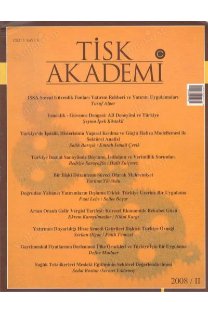Türk imalat sanayiinde geri ve ileri bağlantılar: Girdi-çıktı tablosuna dayalı yapısal bir çözümleme
Backward and forward linkages in Turkish manufacturing industry: A structural analysis based on input-output table
___
- Andreosso-O’Callaghan, B. ve Yue, G. (2000). Intersectoral Linkages and Key Sectors in China 1987-1997 - An Application of Input- Output Linkage Analysis. Paper presented at the 13th International Conference on Input-Output Techniques. Macerata, Italy.
- Aydın, H. (2007). An Analysis of Input Output Inter Industry Linkages in the Turkish Economy. 16th International Input Output Conference. İstanbul.
- Aydoğuş, O. (2010). Girdi-Çıktı Modellerine Giriş. Gözden Geçirilmiş 3. bs. Ankara: Efil Yayınevi
- Dasgupta, P. ve Chakraborty, D. (2005). The Structure Of The Indian Economy. 15th International Input-Output Conference. Beijing, China.
- Demir, N. ve Kula, M. (2008). Türkiye Ekonomisinin Sektörler Arası Bağlantıları nda İhracat-İthalat İlişkileri. Uluslararası Ekonomi ve Dış Ticaret Politikaları. 3(1-2).
- Drejer, I. (2002). Input-Output Based Measures of Interindustry Linkages Revisited A Survey and Discussion. Paper presented at the 14th International Conference on Input Output Techniques. Montreal, Canada.
- Han, E. (1995). Kalkınma Planlaması. 4. bs. Eskişehir: Metin Ofset Matbaacılık Han, E. ve Kaya, A.A. (2006). Kalkınma Ekonomisi, Teori ve Politika. Ankara: Nobel Yayınevi
- Hirschman, A. O. (1958). The Strategy of Economic Development. New Haven and London: Yale University Press
- Kepenek, Y. (1977). Türkiye İmalat Sanayinin Üretim Yapısı. Ankara: ODTÜ Kula, M. (2008). Supply-Use and Input Output Tables, Backward and Forward Linkages of the Turkish Economy. The 16th Inforum World Conference in Northern Cyprus.
- Laumas, P. S. (1976). The Weighting Problem in Testing the Linkage Hypothesis. Quarterly Journal of Economics. Vol. 90, No. 2.
- Pfajfar, L. (2000). Intersectoral Linkages in the Slovenian Economy in the Years 1990, 1992 and 1993: Key Sectors in the Slovenian Economy. 10 Ocak 2010 tarihinde http://miha.ef.unilj. si/_dokumenti/wp/pfajfar1.doc adresinden erişildi.
- Shuja, N., Wah, Y. B., Lazim, M.A. ve Okamoto, N. (2008). Identifying Key Sectors of Malaysian Economy: A Comparison of Unweighted and Weighted Approaches. 12 Ocak 2010 tarihinde http://www.statistics. gov.my/portal/images/stories/files/ journalDOSM/ ArticleIIVol12008.pdf ?phpMyAdmin=HsSjziTw4modEUBuL5A5eWr139e adresinden erişildi.
- Şenesen, G. G. (2005). Türkiye’nin Üretim Yapısı: Girdi-Çıktı Modeli Temel Bulgular. TÜSİAD Büyüme Stratejileri Dizisi No. 3. İstanbul: TÜSİAD
- Temurshoev, U. (2004). Key Sectors in the Kyrgystan Economy. Discussion Paper, No. 2004-135, November. Charles University.
- Turkish Statistical Institute - TÜİK (2008). Supply, Use and Input-Output Tables 2002. No: 3146, 978–975–19– 4240–1. Ankara: Turkish Statistical Institute Press
- Yay, G. G. ve Keçeli, S. (2009). The Intersectoral Linkage Effects in Turkish Economy: An Application of Static Leontief Model. PANOECONOMICUS. 2009- 3
- ISSN: 1306-6757
- Yayın Aralığı: 2
- Başlangıç: 2006
- Yayıncı: Türkiye Isveren Sendikalari Konfederasyonu
Finansal serbestleşme ve firma finansmanı
Cinsiyete bağlı insani gelişme endeks yaklaşımları: Türkiye örneği
İşyerinde şiddet davranışlarının çalışanlar üzerindeki etkisi: Bir uygulama
SALİH DURSUN, SEVİNÇ SERPİL AYTAÇ
Ekrem KARAYILMAZLAR, DOĞAN BAKIRTAŞ
İş sözleşmesinin geçerli sebeple feshinde ultima ratio ve sosyal seçim ilkeleri
Türk imalat sanayiinde geri ve ileri bağlantılar: Girdi-çıktı tablosuna dayalı yapısal bir çözümleme
